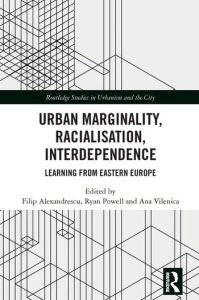 Megjelent Virág Tünde Messing Verával közösen írt tanulmánya, a ’Urban Marginality, Racialization, Interdepence’ című kötetben F. Alexandrescu, R. Powell és A. Vilenica szerkesztésében. A tanulmány egy, a többségi társadalom által etnikai „gettónak” bélyegzett, ugyanakkor etnikailag, vallásilag és társadalmilag sokszínű városrész kormányzásának elemzésén keresztül feltárja a különböző társadalmi csoportok láthatatlanná tételének és rasszizálásának egymással összefüggő mechanizmusait. Bemutatják, hogy egy társadalmilag és etnikailag sokszínű városnegyed hogyan konstruálódik „gettóként”, és az egymást követő városvezetések hogyan kérdőjelezik meg vagy éppen erősítik fel a városrész kriminilizálását és stigmatizációját. Wacquant „gettó” és „anti-gettó” fogalmát Cohen morális pánik elméletével összekapcsolva feltárjuk, hogy hogyan konstruálódik a nemkívánatos társadalmi csoportokról alkotott kép és ez hogyan igazodnak a kormányzó szereplők politikai igényeihez.
Megjelent Virág Tünde Messing Verával közösen írt tanulmánya, a ’Urban Marginality, Racialization, Interdepence’ című kötetben F. Alexandrescu, R. Powell és A. Vilenica szerkesztésében. A tanulmány egy, a többségi társadalom által etnikai „gettónak” bélyegzett, ugyanakkor etnikailag, vallásilag és társadalmilag sokszínű városrész kormányzásának elemzésén keresztül feltárja a különböző társadalmi csoportok láthatatlanná tételének és rasszizálásának egymással összefüggő mechanizmusait. Bemutatják, hogy egy társadalmilag és etnikailag sokszínű városnegyed hogyan konstruálódik „gettóként”, és az egymást követő városvezetések hogyan kérdőjelezik meg vagy éppen erősítik fel a városrész kriminilizálását és stigmatizációját. Wacquant „gettó” és „anti-gettó” fogalmát Cohen morális pánik elméletével összekapcsolva feltárjuk, hogy hogyan konstruálódik a nemkívánatos társadalmi csoportokról alkotott kép és ez hogyan igazodnak a kormányzó szereplők politikai igényeihez.
Messing Vera – Virág Tünde (2025). Doing and undoing communities Opposing municipal narratives and spatial politics in a diverse neighbourhood of Budapest. In. Alexandrescu, Powell and Vilenaica (eds) Urban Marginality, Racialization, Interdependence. Learning from Eastern Europe. Abingdon, New York: Routledge. (pp 189-209) ISBN: 9781032588575. DOI: 10.4324/9781003451785
Abstract
This chapter provides an analysis of governing an urban area historically characterized by high levels of ethnic, racial, religious, and social diversity and related urban marginality, yet stigmatized as an ethnic “ghetto” by mainstream society for several decades. We applied Wacquant’s conceptual framework “ghetto” and “anti-ghetto” as a relational, theoretical, and historicized concept to explore the interconnected mechanism of invisibilization and racialization of different local groups. In the chapter we analyse how a socially and ethnically diverse neighbourhood had been constructed as a “ghetto” and how different municipalities contested or endorsed the criminal and racial stigma attached to the place. To do so, we connect Waquantian concepts with Cohen’s notion of moral panic to reveal key elements in the construction of the imaginary of unwanted populations and how these are adapted to the political needs of the governing actors.


